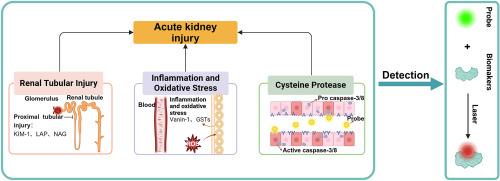Advances in near-infrared fluorescence imaging for early detection of acute kidney injury
IF 4.2
3区 工程技术
Q2 CHEMISTRY, APPLIED
引用次数: 0
Abstract
Acute kidney injury (AKI) is a severe clinical condition with complex pathogenesis and high morbidity. Early diagnosis is vital for improving outcomes, but traditional markers such as serum creatinine and urine output lack sensitivity and timeliness. Near-infrared (NIR) fluorescence imaging has emerged as a promising tool for early AKI detection due to its deep tissue penetration, high sensitivity, and real-time monitoring capability. This review summarizes the design strategies of NIR fluorescent probes, including fluorophore optimization, linker engineering, and targeting group selection. We focus on their applications in detecting AKI biomarkers, such as Vanin-1, KIM-1, and LAP, which enable sensitive detection in urine or kidney tissue through enzymatic or receptor-mediated mechanisms. Probes targeting oxidative stress markers like reactive oxygen species and peroxynitrite further allow dynamic visualization of early AKI-related changes. Despite their advantages, clinical translation of NIR probes faces challenges, including biocompatibility, targeting precision, imaging depth, and integration with multimodal platforms. Continued optimization of probe design is essential to advance their use in early AKI diagnosis and precision medicine.

近红外荧光成像在急性肾损伤早期检测中的研究进展
急性肾损伤(AKI)是一种发病复杂、发病率高的严重临床疾病。早期诊断对改善预后至关重要,但血清肌酐和尿量等传统指标缺乏敏感性和及时性。近红外(NIR)荧光成像因其深入组织,高灵敏度和实时监测能力而成为早期AKI检测的有前途的工具。本文综述了近红外荧光探针的设计策略,包括荧光团优化、连接体工程和靶向基团选择。我们专注于它们在检测AKI生物标志物方面的应用,如Vanin-1、KIM-1和LAP,它们可以通过酶或受体介导的机制在尿液或肾脏组织中进行敏感检测。针对氧化应激标志物(如活性氧和过氧亚硝酸盐)的探针进一步实现了早期aki相关变化的动态可视化。尽管具有优势,但近红外探针的临床翻译面临着挑战,包括生物相容性、靶向精度、成像深度以及与多模式平台的集成。持续优化探针设计对于推进其在早期AKI诊断和精准医疗中的应用至关重要。
本文章由计算机程序翻译,如有差异,请以英文原文为准。
求助全文
约1分钟内获得全文
求助全文
来源期刊

Dyes and Pigments
工程技术-材料科学:纺织
CiteScore
8.20
自引率
13.30%
发文量
933
审稿时长
33 days
期刊介绍:
Dyes and Pigments covers the scientific and technical aspects of the chemistry and physics of dyes, pigments and their intermediates. Emphasis is placed on the properties of the colouring matters themselves rather than on their applications or the system in which they may be applied.
Thus the journal accepts research and review papers on the synthesis of dyes, pigments and intermediates, their physical or chemical properties, e.g. spectroscopic, surface, solution or solid state characteristics, the physical aspects of their preparation, e.g. precipitation, nucleation and growth, crystal formation, liquid crystalline characteristics, their photochemical, ecological or biological properties and the relationship between colour and chemical constitution. However, papers are considered which deal with the more fundamental aspects of colourant application and of the interactions of colourants with substrates or media.
The journal will interest a wide variety of workers in a range of disciplines whose work involves dyes, pigments and their intermediates, and provides a platform for investigators with common interests but diverse fields of activity such as cosmetics, reprographics, dye and pigment synthesis, medical research, polymers, etc.
 求助内容:
求助内容: 应助结果提醒方式:
应助结果提醒方式:


